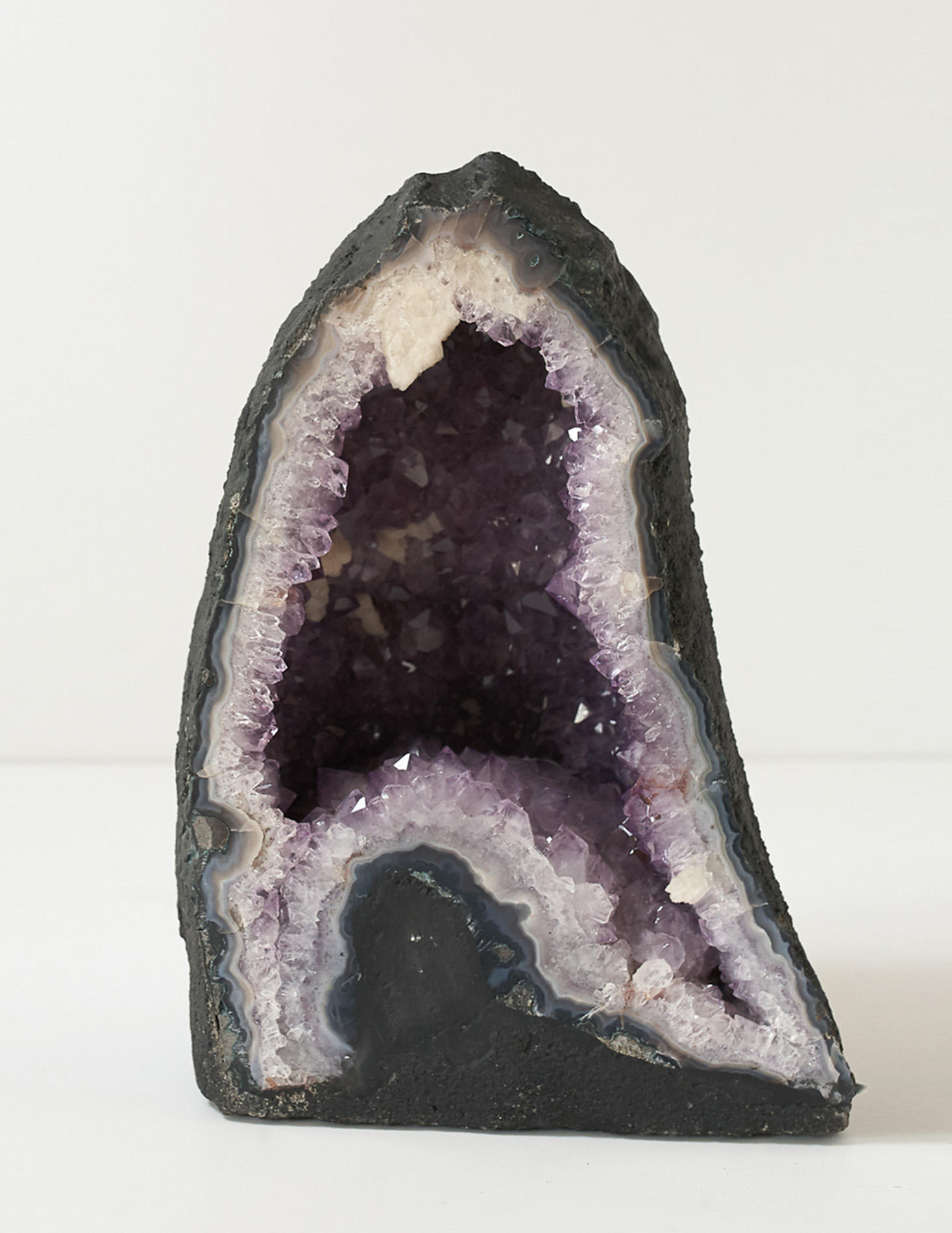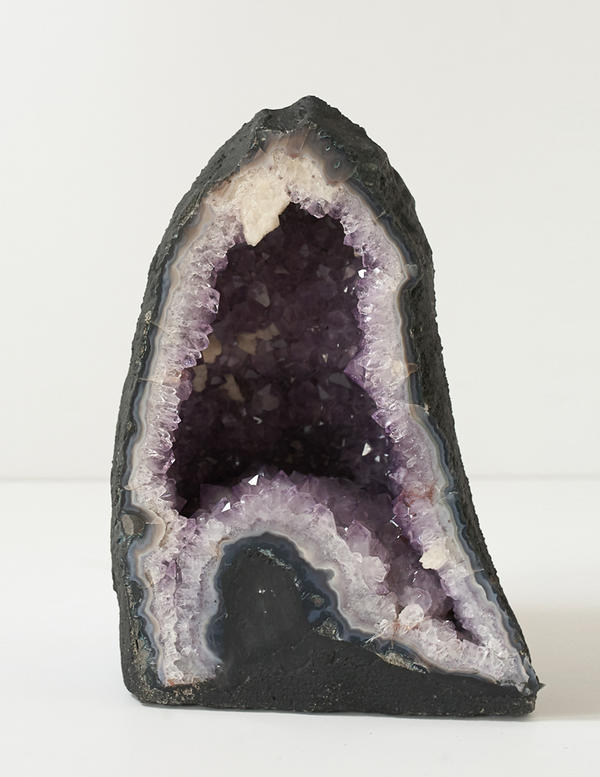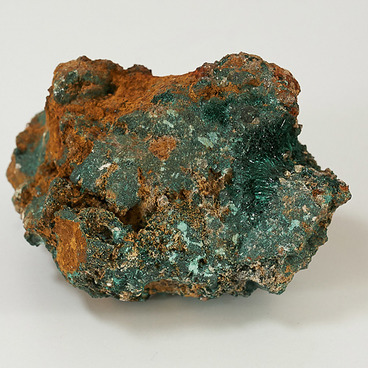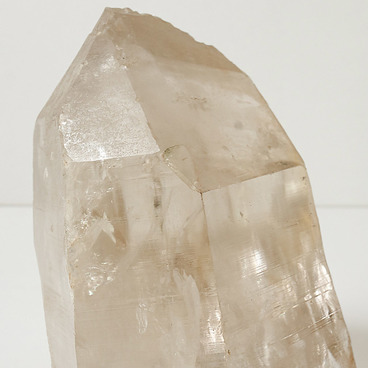This amethyst geode was found on the territory of the Kuznetsk Alatau in Kemerovo Region. Geode is a hollow geological formation filled with crystals found in volcanic or sedimentary rocks. After the solidification of the rock around air bubbles in basaltic lava, or in cavities of sedimentary rocks inside the voids, an amazing process of crystal growth begins. Crystals are based on mineral components dissolved in groundwater or hydrothermal solutions.
Geode sizes range from miniature amygdales to human-height caves. Usually, these are rounded formations of irregular shape. Sometimes crystalline druses of sparkling gems grow inside the body of a geode, a real find for collectors. Over time, the rocks containing geodes disappear, revealing to the researcher’s eyes these fabulous caves full of treasures. Geodes with amethyst druses are of particular value. Large objects are stored at the place of detection, attracting tourists. Smaller geodes adorn museum exhibitions.
This fairly large geode found in the Kuznetsk Alatau has the shape of an irregular cone. It is filled with a violet amethyst druse framed by colorless crystals. Amethyst is a colored variety of quartz having a wide range of shades, from light pink to dark purple. Transparent crystals are semiprecious stones; opaque ones are used as a valuable ornamental material. The best amethysts are found in Siberia and Brazil, in the Far East and on Sri Lanka.
Amethyst slightly changes its color depending on illumination and angle of view. The color stability of the stones depends on the deposit. So, crystals from crystal-like veins remain invariably bright even in direct sunlight, while amethysts grown in geodes among sedimentary rocks usually fade quickly even under the influence of diffused or reflected sunlight.
The Siberian land is rich in especially valuable stones of deep purple color with a tint of blue or red. All over the world, they are called Siberian (Deep Siberian) amethysts. The crystals of natural amethyst have the form of a prism with rectangular or rhombic facets. Rhombohedra are most characteristic of amethysts, which distinguishes them from other quartz. Sometimes crystals acquire a long prismatic or scepter-like shape.
Amethysts have been known since ancient times, not only as jewelry and ornamental stones. Mystical properties were attributed to them; it was believed that they protected against alcohol intoxication. Actually, the name of the mineral itself is derived from the word ἀμέθυστος, which is translated from Koyne (an ancient pan-Greek dialect) as “not drunk”, “non-intoxicating”. Science has long debunked the myth of the magical properties of amethyst, but the passage of centuries has not affected people’s admiration towards the beauty of these bright crystals grown in the bowels of the mountains.
Geode sizes range from miniature amygdales to human-height caves. Usually, these are rounded formations of irregular shape. Sometimes crystalline druses of sparkling gems grow inside the body of a geode, a real find for collectors. Over time, the rocks containing geodes disappear, revealing to the researcher’s eyes these fabulous caves full of treasures. Geodes with amethyst druses are of particular value. Large objects are stored at the place of detection, attracting tourists. Smaller geodes adorn museum exhibitions.
This fairly large geode found in the Kuznetsk Alatau has the shape of an irregular cone. It is filled with a violet amethyst druse framed by colorless crystals. Amethyst is a colored variety of quartz having a wide range of shades, from light pink to dark purple. Transparent crystals are semiprecious stones; opaque ones are used as a valuable ornamental material. The best amethysts are found in Siberia and Brazil, in the Far East and on Sri Lanka.
Amethyst slightly changes its color depending on illumination and angle of view. The color stability of the stones depends on the deposit. So, crystals from crystal-like veins remain invariably bright even in direct sunlight, while amethysts grown in geodes among sedimentary rocks usually fade quickly even under the influence of diffused or reflected sunlight.
The Siberian land is rich in especially valuable stones of deep purple color with a tint of blue or red. All over the world, they are called Siberian (Deep Siberian) amethysts. The crystals of natural amethyst have the form of a prism with rectangular or rhombic facets. Rhombohedra are most characteristic of amethysts, which distinguishes them from other quartz. Sometimes crystals acquire a long prismatic or scepter-like shape.
Amethysts have been known since ancient times, not only as jewelry and ornamental stones. Mystical properties were attributed to them; it was believed that they protected against alcohol intoxication. Actually, the name of the mineral itself is derived from the word ἀμέθυστος, which is translated from Koyne (an ancient pan-Greek dialect) as “not drunk”, “non-intoxicating”. Science has long debunked the myth of the magical properties of amethyst, but the passage of centuries has not affected people’s admiration towards the beauty of these bright crystals grown in the bowels of the mountains.



